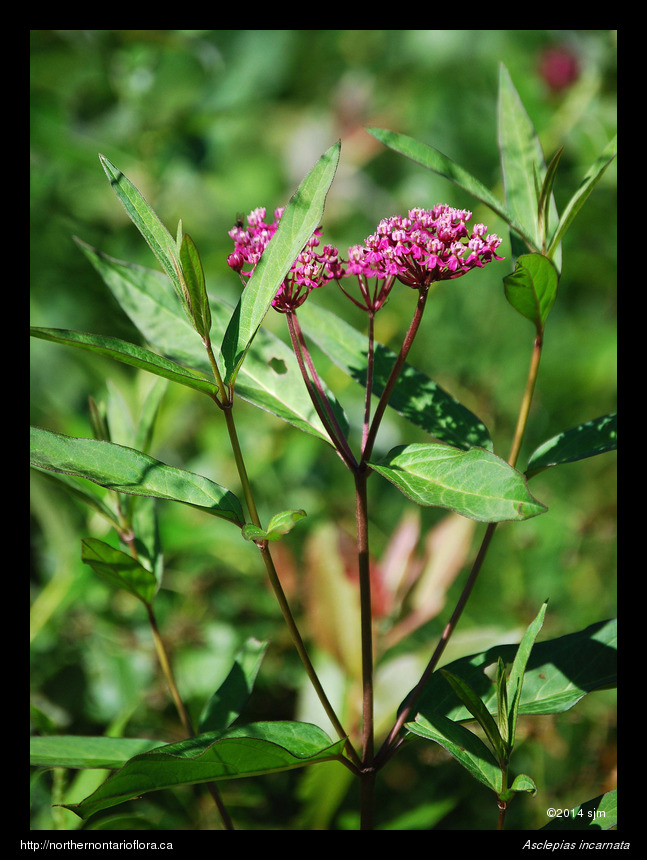
|
Northern Ontario Plant Database 
Plant DescriptionAsclepias incarnata L.En: swamp milkweed
Apocynaceae (Dogbane Family) General: An erect perennial herb, 1—1.5 m tall, arising from a deep taproot. Mature plants produce several erect shoots from the base. Warning: All parts of the plant have a milky-white sap that contains poisonous glycosides. The bitter sap deters most insect predators, but monarch caterpillars are apparently immune and feed exclusively on milkweed plants, retaining the poisonous qualities of the sticky white sap as adult monarchs, making them unpalatable to predators. Swamp milkweed, planted in wet areas of rights-of-way, provides egg-laying sites for monarch butterflies and food for their larvae. Leaves: Opposite, simple, 7.5—16 cm long by 1—4 cm wide, with a short petiole and pinnate venation. The dark green leaf blades are narrowly lanceolate to elliptic, bases are rounded or, less often, slightly tapering; apices are sharply pointed (acuminate); margins are entire. Flowers: Many flowers are arranged in terminal and axillary flat-topped clusters (umbels), usually with several umbels grouped together. The deep pink to reddish flowers have 5 lanceolate sepals and petals, 6—7 mm long, valvate in bud and reflexed in flower. The pistil, composed of two superior ovaries that share a common style and stigma, form an enlarged stylar head in the centre of the flower, which is surrounded by 5 highly modified stamens. The stalks (filaments) of the stamens are fused together to form a fleshy, star-shaped, pale pink to whitish corona divided into 5 segments, each consisting of a hood, 2—3 mm tall, with an incurved horn emerging from within the hood and arching over the stylar head. Each of the 5 anthers has two waxy pollen masses (pollinia) joined by a thin thread-like connection. Pollination occurs when a visiting insect accidentally pushes one of the pollinia into the stigmatic area of the stylar head while sipping nectar. Fruit: The lanceolate pods (follicles) are 5—9 cm long, held erect, and taper gradually towards the narrow tip. The pod's surface is slightly hairy when young, but lacks the spiny bumps (protuberances) of common milkweed pods. When mature, the pods turn brown and split open (dehisce) along one side to release numerous flat seeds, each bearing a tuft of long silky hairs (coma) that aid in wind dispersal. Habitat and Range: Wet habitats, such as stream and pond margins, swamps, wet meadows, wet depressions, and wet thickets. Swamp milkweed is native to eastern Canada and most of the U.S. In Ontario, swamp milkweed extends north to at least the Batchawana region of the Algoma District and southwestern portions of northwestern Ontario. Similar Species: The only other milkweed species well-distributed in northeastern Ontario is the common milkweed (Asclepias syriaca L.), which is easily distinguished by its larger stiff oblong leaves and lighter pink to purplish flowers. Common milkweed is found in drier, usually disturbed, habitats, such as fallow fields, railway rights-of-way, and roadsides. In northeastern Ontario, green milkweed (Asclepias viridiflora Raf.) has been collected only on the LaCloche Peninsula, near Manitoulin Island. Green milkweed grows on basic soils and can be recognized by its green flowers and narrow pods; its hairy leaves are similar to, but are narrower and more pointed at the apex, than those of common milkweed. Back to species list |
||||||||||||||||||||||



















